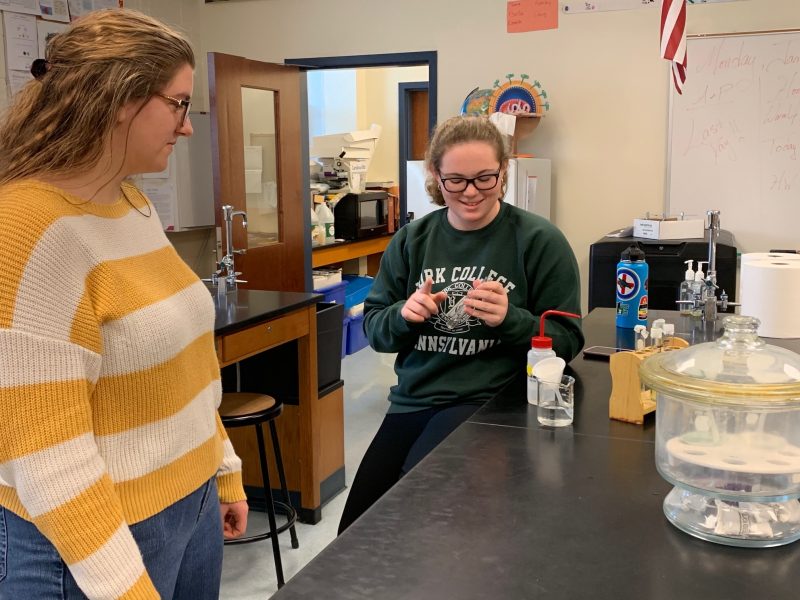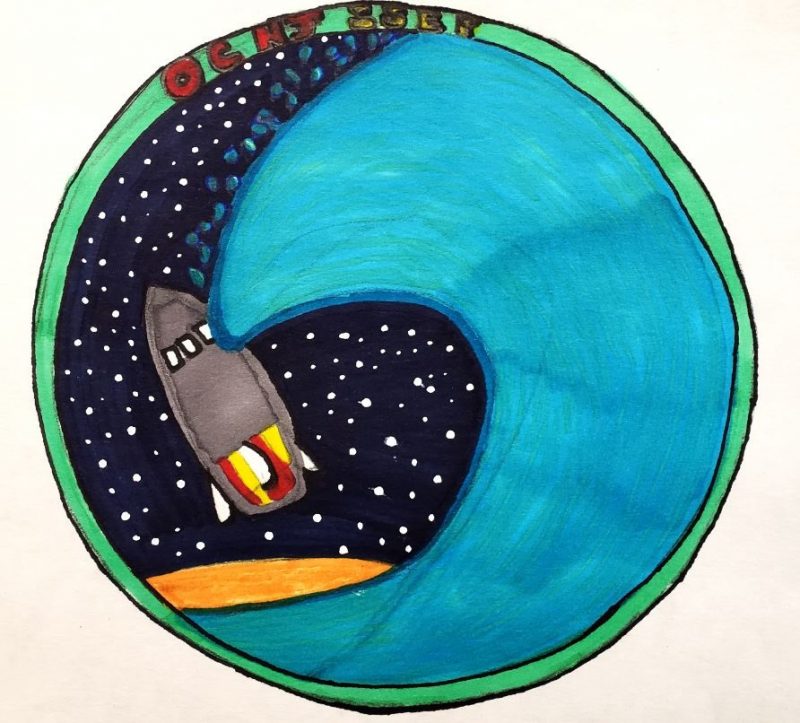Ocean City High School sophomore Madison Morgan, left, and junior Abigail Craige prepare to package an experiment that astronauts will carry out on the International Space Station. (Photos Courtesy Ocean City School District)
 Three Ocean City High School students will conduct research this year on the International Space Station as part of the Student Spaceflight Experiments Program (SSEP) Mission 13.
Juniors Abigail Craige and Alexia Schmidt and sophomore Madison Morgan are finalizing their protocols and assembling their materials in preparation for their experiment’s launch into space in spring or summer.
Astronauts will then follow the students’ directions to help gather data about the effects of microgravity on the growth rates and sex ratios of brine shrimp.
The students ultimately hope that their data analysis reveals how brine shrimp can serve as a sustainable food source for astronauts.
“We developed this experiment to test a creative way to offer astronauts both an alternative food source and a method of recycling,” Abigail said in a press release.
Abigail and Alexia initially put together the proposal for the experiment, building upon previous research findings and consulting with Ocean City High School teachers.
After learning that their proposal topped nine other proposals from OCHS and five from Ocean City Intermediate School (OCIS) to represent the Ocean City School District in the SSEP Mission 13, they recruited Madison to help prep the experiment.
Madison had submitted another strong proposal for studying how mother of pearl enhances bone growth in space.
“We were impressed with the quality of the proposals from our Ocean City students,” said OC Life 21 advisors David Uhrich and Daniel Weaver, also both OCHS physics teachers.
They helped advise the OCHS students through the proposal process.
Abigail, Alexia and Madison received additional guidance from OCHS biology teacher Catherine Georges, as they worked in a short period from the time the proposal was selected to the time they needed to submit the final proposal for signoff by SSEP organizers. They continue to work in Georges’ lab to test their proposed experiment and how to best package it.
“I am hands-off unless the students need my input,” said Georges. “They are conducting the experiment on the ground, seeing what does and doesn’t work, brainstorming what could go wrong, and then making necessary adjustments.”
Georges continued, “The district has been supportive in helping to get them the supplies they need, and the return on that investment is immeasurable. These students are engaging in high-level research.”
Schools Superintendent Dr. Kathleen Taylor said, “We are proud to offer this unique opportunity to our students, because it will help them develop new skills, explore possibilities for the future and gain a competitive advantage over their peers when they go to apply for college or a job.”
She added, “We often tell them to reach for the stars and that the sky is the limit, but now that their work has reached outer space, we will need to rethink that. Our students’ success is truly limitless.”
Three Ocean City High School students will conduct research this year on the International Space Station as part of the Student Spaceflight Experiments Program (SSEP) Mission 13.
Juniors Abigail Craige and Alexia Schmidt and sophomore Madison Morgan are finalizing their protocols and assembling their materials in preparation for their experiment’s launch into space in spring or summer.
Astronauts will then follow the students’ directions to help gather data about the effects of microgravity on the growth rates and sex ratios of brine shrimp.
The students ultimately hope that their data analysis reveals how brine shrimp can serve as a sustainable food source for astronauts.
“We developed this experiment to test a creative way to offer astronauts both an alternative food source and a method of recycling,” Abigail said in a press release.
Abigail and Alexia initially put together the proposal for the experiment, building upon previous research findings and consulting with Ocean City High School teachers.
After learning that their proposal topped nine other proposals from OCHS and five from Ocean City Intermediate School (OCIS) to represent the Ocean City School District in the SSEP Mission 13, they recruited Madison to help prep the experiment.
Madison had submitted another strong proposal for studying how mother of pearl enhances bone growth in space.
“We were impressed with the quality of the proposals from our Ocean City students,” said OC Life 21 advisors David Uhrich and Daniel Weaver, also both OCHS physics teachers.
They helped advise the OCHS students through the proposal process.
Abigail, Alexia and Madison received additional guidance from OCHS biology teacher Catherine Georges, as they worked in a short period from the time the proposal was selected to the time they needed to submit the final proposal for signoff by SSEP organizers. They continue to work in Georges’ lab to test their proposed experiment and how to best package it.
“I am hands-off unless the students need my input,” said Georges. “They are conducting the experiment on the ground, seeing what does and doesn’t work, brainstorming what could go wrong, and then making necessary adjustments.”
Georges continued, “The district has been supportive in helping to get them the supplies they need, and the return on that investment is immeasurable. These students are engaging in high-level research.”
Schools Superintendent Dr. Kathleen Taylor said, “We are proud to offer this unique opportunity to our students, because it will help them develop new skills, explore possibilities for the future and gain a competitive advantage over their peers when they go to apply for college or a job.”
She added, “We often tell them to reach for the stars and that the sky is the limit, but now that their work has reached outer space, we will need to rethink that. Our students’ success is truly limitless.”
